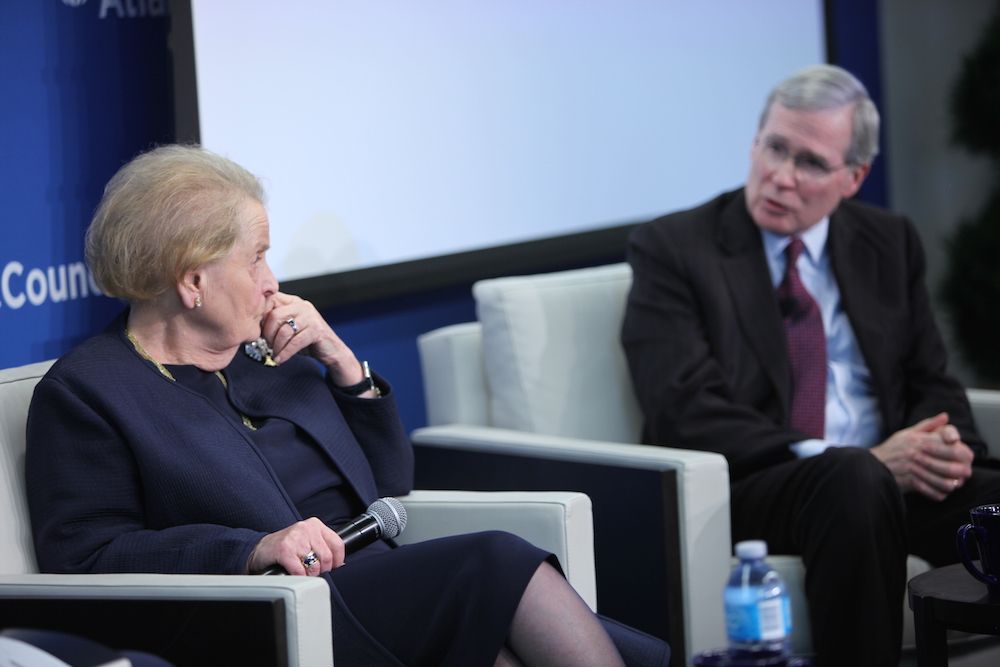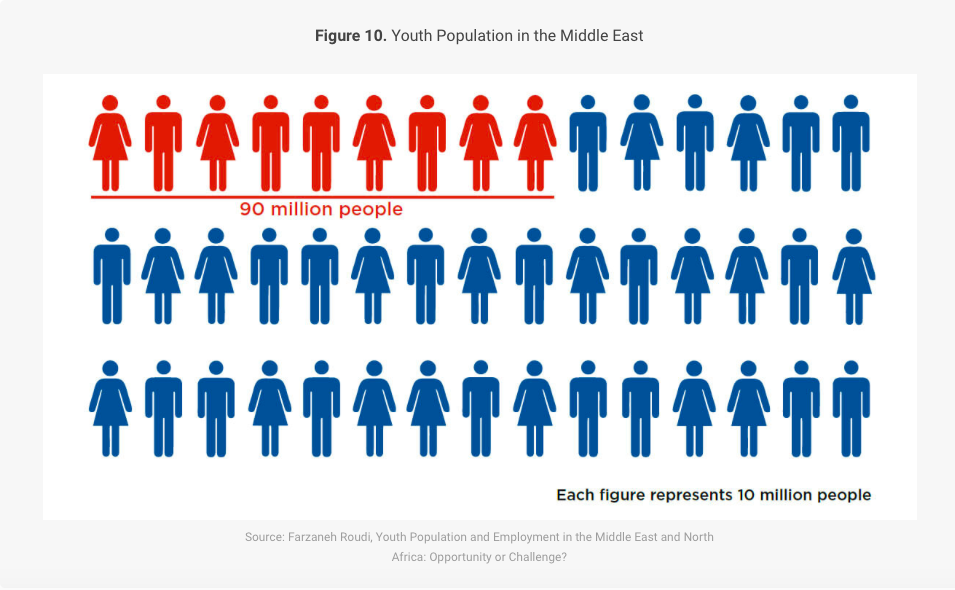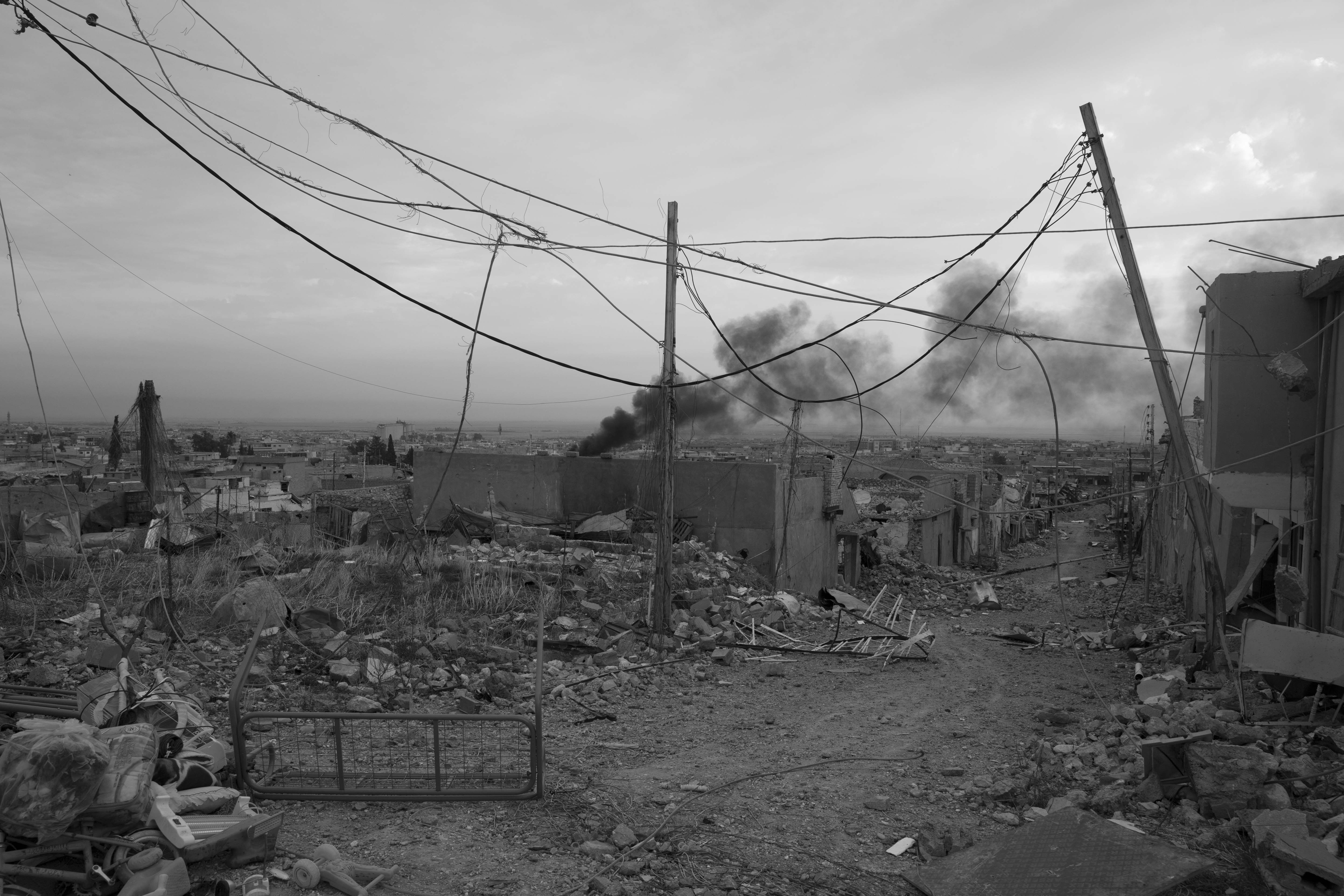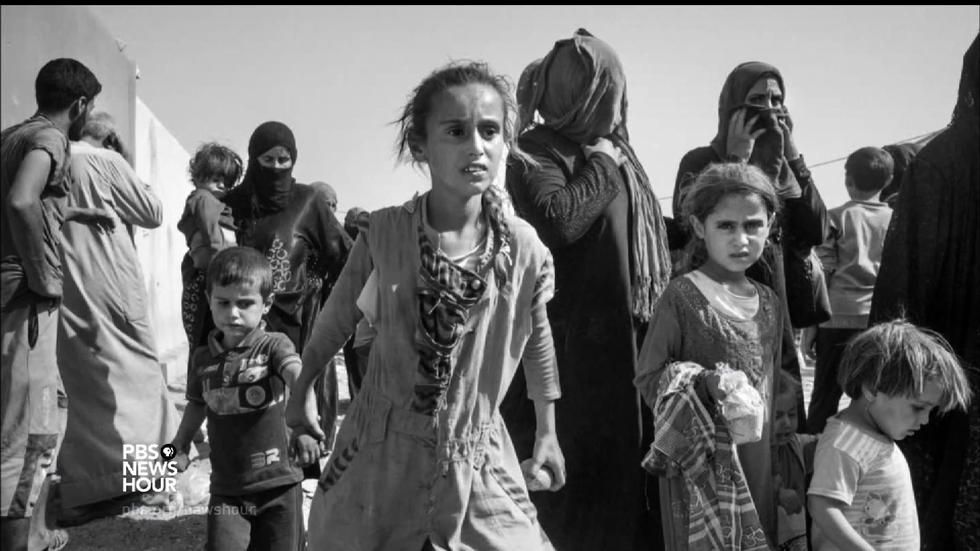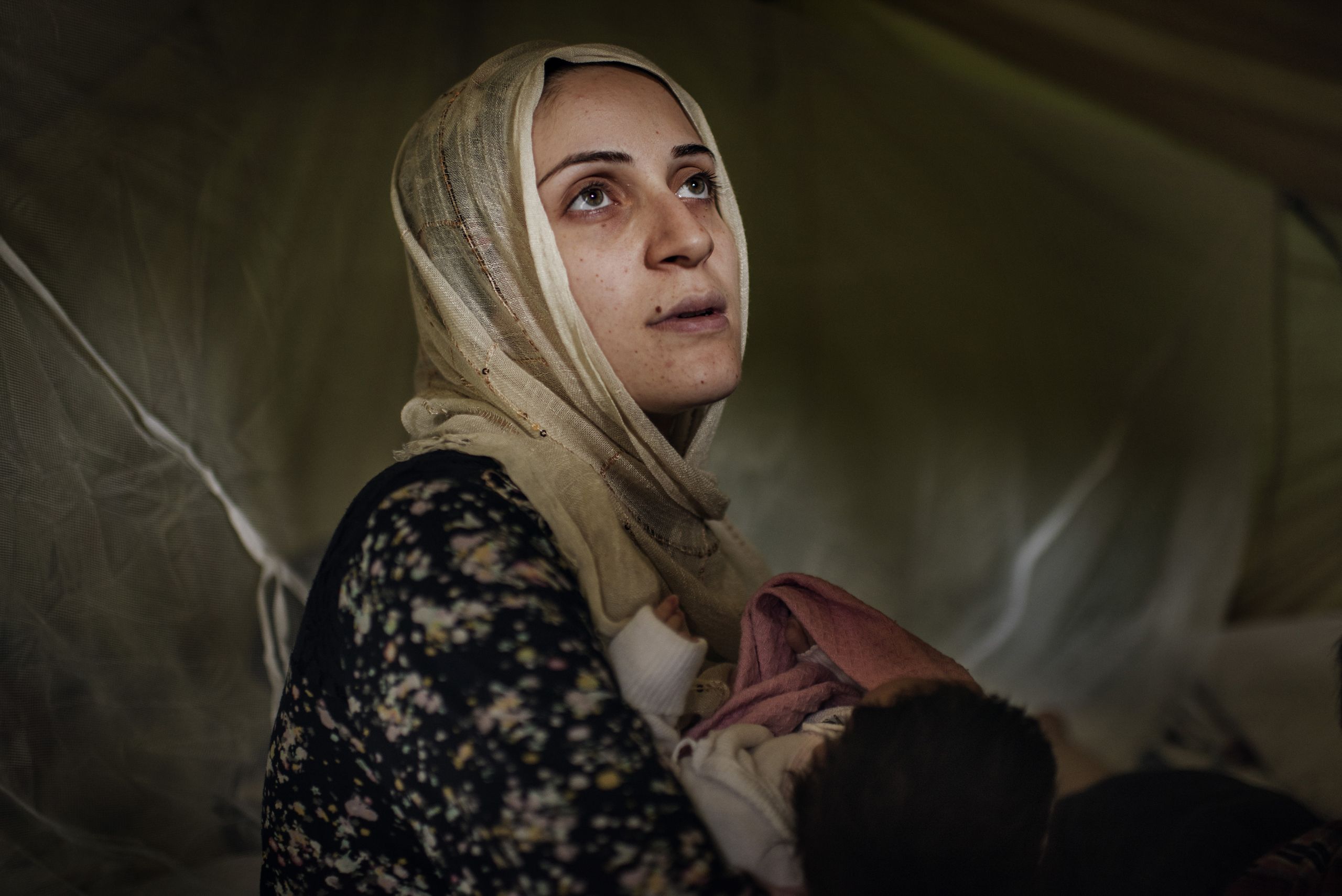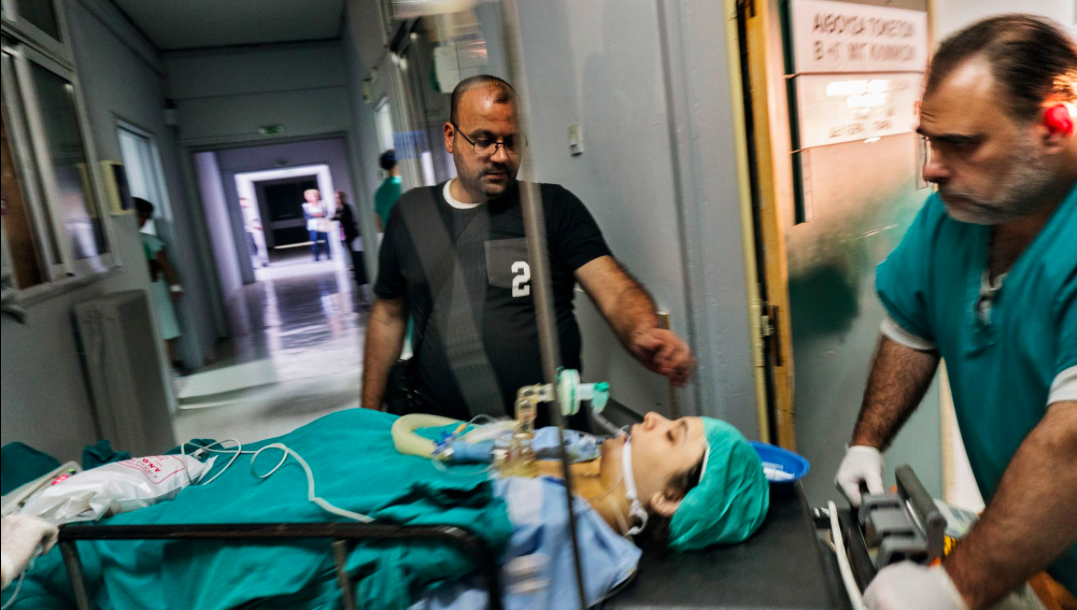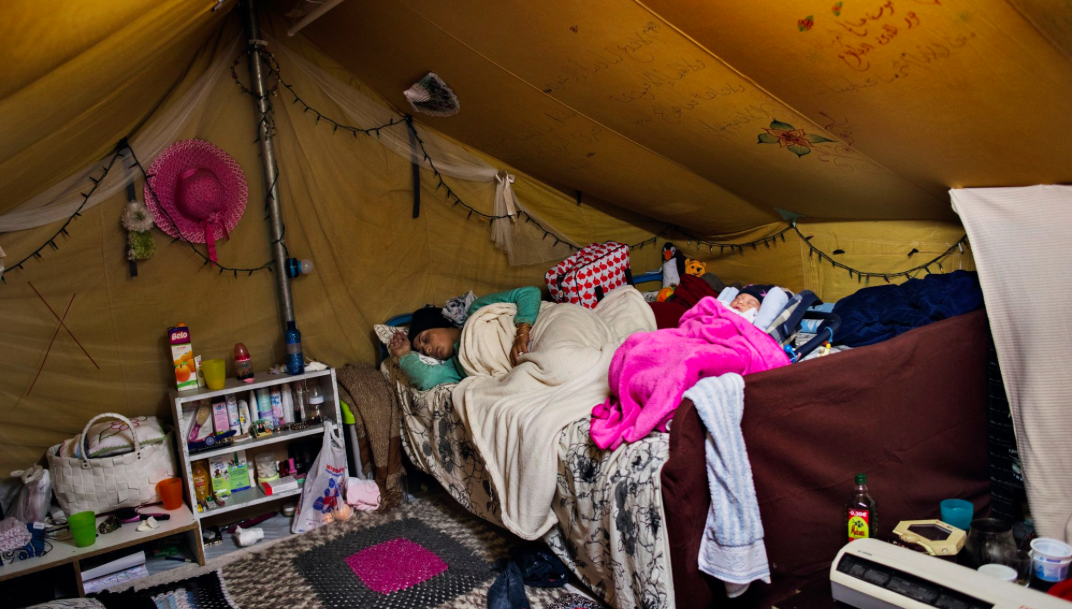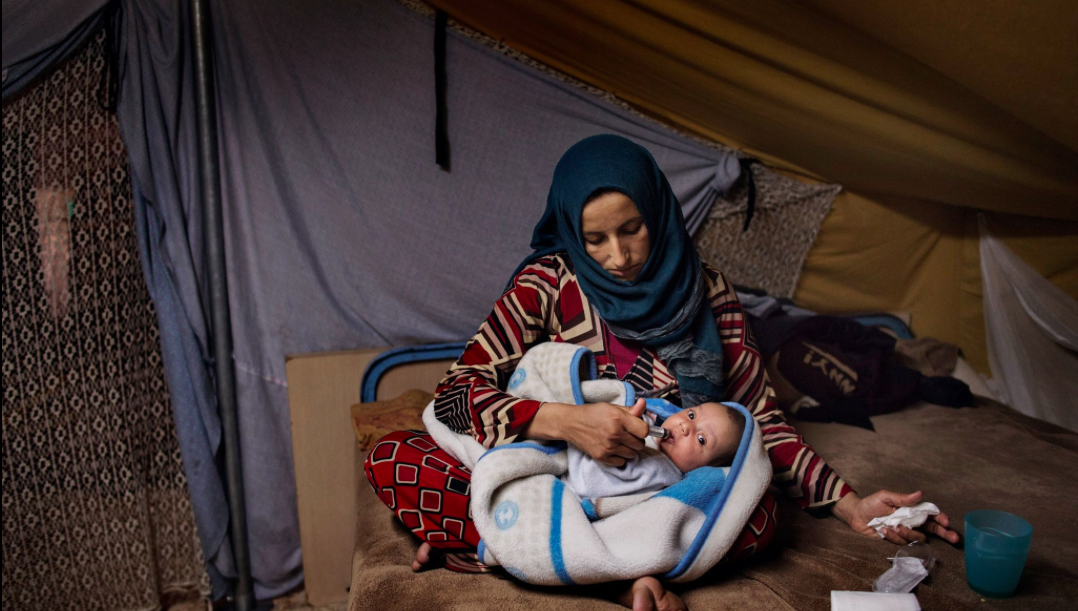INTRODUCTION
The Middle East is in crisis. The Arab Spring of 2011, a period of popular uprising throughout the region that many hoped would lead to a new era of freedom and human rights, has given way to destabilized or failed states, war, and a refugee crisis that has displaced millions.
The Pulitzer Center, in partnership with the Atlantic Council, the New York Times, and Time, has supported major journalism projects covering the region in an effort to help readers understand the current challenges and prospects for the future.
PART I: Middle East Strategy Task Force
In just a few weeks, former US Secretary of State Madeleine Albright, former US National Strategy Advisor Stephen Hadley and Pulitzer Center Executive Director Jon Sawyer will visit your campus to engage in a discussion around the contemporary Middle East.
Under the bipartisan Co-Chairmanship of Secretary Albright and Mr. Hadley, the Atlantic Council, an international affairs think tank, convened the Middle East Strategy Task Force (MEST) in February 2015 to examine the underlying issues of state failure and political legitimacy that drive extremist violence and threaten fundamental interests broadly shared by the peoples of the region and the rest of the world.
Read the Middle East Strategy Task Force Executive Summary:
The Middle East is not condemned to a debilitating cycle of conflict. There is nothing inevitable or unfixable about what ails the states of the region today. Still, the current reality is alarmingly clear: a global crisis emanating from the Middle East convulsing much of the region in instability and violence, while projecting the threat and reality of terrorism and disruption far beyond.
That threat and that reality are palpable, but so is the prospect for a better future. There are opportunities in the Middle East, not just challenges.
To be able to harness these opportunities, it is necessary to change the political trajectory of the region from state failure and civil war toward a stable and peaceful order of sovereign states. It goes without saying that the states and peoples of the Middle East have the greatest stake in what happens there. Yet the United States also has vital interests that impact both the lives and livelihoods of Americans and their families: keeping citizens safe from terrorism; protecting the US economy; empowering friends and allies; enabling American global military operations; preventing the spread of weapons of mass destruction; and averting destabilizing humanitarian disasters.
Advancing American interests will require far more than a unilateral “American strategy.” Outsiders cannot fix what ails the Middle East. Neither can they avoid its global consequences through some combination of defense, disengagement, and containment. The current crisis in the Middle East is not containable. Isolationism is a dangerous illusion.
KEY POINTS OF EXECUTIVE SUMMARY
A NEW STRATEGIC APPROACH LED BY THE REGION
What we propose here is a New Strategic Approach emphasizing partnership.
Under this New Approach, the leaders and peoples of the region must take full responsibility for charting a new, positive vision for their societies. At the same time, outsiders such as the United States would work to help resolve the violent conflicts that currently stand in the way of achieving any region-led vision.
This New Strategic Approach is a bet on the people of the region.
The partnership that it envisions reaches out to the full range of regional actors, not just governments. Youth, women, private business, local civic groups, entrepreneurs, philanthropists, educators, and engaged citizens all have a role to play. What is required is a Whole-of-Region approach.
The New Strategic Approach envisions a two-pronged action agenda, implemented simultaneously.
External powers will take the lead along with regional actors in winding down civil wars, mitigating human suffering, and relieving the Islamic State of Iraq and al-Sham (Daesh) of its territory. At the same time, regional actors, with support from external powers, will work to unlock the region’s rich, but largely untapped, human capital—especially the underutilized talents of youth and women.
This complementary division of efforts between external and internal actors represents a Compact for the Middle East
It abrogates outdated assumptions that countries and peoples must choose between security and more open societies. The more steps countries in the region take to improve their governance and the lives of their people, the more legitimacy they will have, and the more support they can expect from the United States and its transatlantic partners.
IMPLEMENTING PRONG ONE: ACHIEVING PEACE AND SECURITY
Prong One, with its emphasis on top-down security issues, requires heavy lifting by external powers in full cooperation with those regional actors willing to participate in this Compact. The required tasks are daunting but doable. They start with the four states of the region engulfed in civil conflict.
In Syria, the humanitarian abuses of the Assad regime provide a recruiting bonanza for Daesh: they must be curtailed—militarily if necessary—and military action probably will prove necessary. Opposition forces must be strengthened to defend civilians from a murderous regime and to go after Daesh and al-Qaeda with enhanced outside support. The defeat of Daesh in Syria must be accelerated, and the reconciliation and reconstruction process for a devastated country must begin. The enhanced military effort must be used as leverage to push the regime and its outside backers toward a political solution. A vital element of this solution will be supporting ground-up efforts that engage local civic groups and Syrians who have been obliged to govern themselves at local levels due to state collapse. If the country is to survive as a single entity, a reconstituted Syrian government must provide increased autonomy and resources that enable provinces and local governments to assume greater responsibility for their citizens and to give their citizens a greater voice in their nation’s future. This is a New Model of National Governance with relevance not just to states emerging from civil war, but also to states of the region seeking enhanced legitimacy and greater support from their people.
In Iraq, the national army—with the full support of external actors— must take the lead in defeating Daesh. To leave this task to Shia militias would be to accelerate Iraq’s downward spiral. The Iraqi government— again, with robust external support and encouragement—must focus on reconciliation and stabilization. That will entail addressing humanitarian needs, overcoming sectarian tensions, restoring effective local governance, and spurring the economic revival of liberated areas. Iraq’s survival as a single state depends in large measure on the government being seen as a more credible guarantor of Sunni Arab interests than Daesh. It also will require, as in the case of Syria, a new model of governance offering increased autonomy and resources for provinces and local governments. External actors should press the government in Baghdad and the Kurdish Regional Government to resolve their differences. Pervasive corruption must also be addressed. Empowered local governance can again provide a major part of the solution, along with strong support for leaders who put themselves at personal risk to tackle graft and vested interests.
In Libya, history dictates a leading role for our European partners. Still, American leadership will be required to galvanize a currently divided Europe and rally external players—including several from the Middle East—to provide unified support to the Government of National Accord, rather than to regional factions.
In Yemen, outside actors must persuade Saudi Arabia to prioritize a political resolution to the conflict. At the same time, Houthi military operations near and across the Saudi border must stop. Like Syria, Yemen has become a humanitarian catastrophe requiring the mitigation efforts of outsiders and regional players alike. And counterterrorism efforts against al-Qaeda’s branch there must continue.
Working to wind down these civil wars will require strong resolve. Yet Prong One of the strategy must address other tasks as well.
Pending the implementation of a stable, sustainable two-state solution to the Israeli-Palestinian conflict, the task of building the institutions of a future Palestinian state should continue and be accelerated, coupled with encouragement to Israel to enhance its economic and security cooperation with the Palestinian Authority. Political changes in Turkey combined with shared interests with the United States require a more robust strategic dialogue between Ankara and Washington. This is critical not only to addressing matters of mutual concern such as refugee flows, Daesh, and the Assad regime, but also to resolving current issues in the US-Turkey bilateral relationship— including relations with the Syrian Kurds.
Iranian interference in the Arab world must be deterred, even while engaging Tehran on matters of mutual interest (such as the 2015 nuclear accord). America’s friends and partners must be reassured that the US opposes Iranian hegemony and will work with them to prevent it.
Support for refugees must move beyond the provision of basic needs toward supporting their economic integration in host countries and empowering their ability to return home. The region needs a different approach toward assisting and supporting refugees and internally displaced persons (IDPs). Adults unable to accumulate savings and children denied education are less likely to return to their home countries and rebuild. Those states bearing the brunt of refugee displacement— Jordan, Lebanon, and Turkey—merit strong and sustained assistance. Their compassion and support for Syrian refugees is a global public good. Yet the burdens are heavy, and creative assistance is needed. For example, cash payments to refugees—rather than in-kind aid disbursements—can stimulate local economies and mitigate local resentments. And contrary to popularly held beliefs, giving refugees legal access to work in local economies can pay huge dividends to the local tax base and produce overall economic growth.
IMPLEMENTING PRONG TWO: UNLEASHING THE REGION’S HUMAN AND ECONOMIC POTENTIAL
Prong Two of the New Strategic Approach emphasizes political and economic transformation, and requires profound reforms of states in the region. These are difficult undertakings requiring strong encouragement from supportive external powers. Yet unless regional states move resolutely toward an Updated Social Contract that empowers citizens and enshrines accountability, the investment being made in the region’s human capital will not bear fruit. Several inter-related steps are necessary for such an updated social contract to take root.
The most crucial step is to develop the region’s human capital— including youth and women—to ensure that change is sustainable. Education is key. Strategic investments must be made in quality education relevant to the twenty-first century. Existing educational institutions require, in many cases, total overhaul, with students and parents fully engaged in educational reform efforts. Indeed, localities should be given greater roles in determining educational priorities at the expense of large, centralized bureaucracies. Targeted interventions, well prepared teachers, thoughtful use of technology, exchange programs, and greater engagement with the American-style liberal arts universities located throughout the region are all essential. Strong vocational training programs should also be developed, recognizing the realistic needs of the labor market.
An associated task is to support and facilitate “Big Bang” Regulatory Reforms to foster greater trade, investment, and economic integration, with a special focus on empowering entrepreneurs. This will ensure that educated citizens find opportunity once their schooling is complete. Governments should not be obstacles to economic creativity. Legal and regulatory environments that enable entrepreneurship to flourish and create an “ecosystem of innovation” are essential, as are protections and incentives for foreign direct investment. Transforming broad subsidies into targeted assistance for the poor, and creating empowered, independent central banks are likewise vitally important. Trade barriers must be lowered and ultimately eliminated. Tunisia—a leader in post-Arab Spring political reforms and in many ways a weathervane for the region—must not be permitted to fail economically.
Governments must both enable and catalyze citizen participation in civic problem-solving. This means giving space for civic activities, encouraging and empowering local civic groups, social entrepreneurs, and especially women and young people to be productive and innovative. It means supporting skills training, civic initiatives, and public dialogues that help create more resilient and vibrant societies. It means encouraging and enabling women to play greater roles in economic and public life. And it means building communications channels between local civic groups and governments.
Good governance—especially empowered and well-resourced local governments—must be a priority. Providing security in the face of terrorism without compromising the rights of citizens is no easy task, but it is a baseline requirement for defeating the terrorist threat. Corruption must be rooted out, delivery of basic services streamlined, and security services professionalized. Local governments should be empowered to solve local problems, and countries should develop their own benchmarks for reform. In all of this, encouragement and support from abroad is important. But initiative from within the region is mandatory.
The Middle East could benefit enormously from a Regional Framework for dialogue and cooperation. This framework would encompass economic, political, and security issues. It would transcend the limited mandates and memberships of existing organizations such as the Arab League, which excludes important regional players like Turkey, Iran, and Israel. Such a framework could help tamp down conflicts, encourage cooperation, establish agreed standards of state behavior, and incentivize and support positive steps by states in the region. A charter could articulate core principles, and a mechanism could be developed to encourage compliance with agreed norms. Such a framework could help wind down the civil wars and might ultimately ratchet-down the Saudi- Iranian confrontation. It would help to establish and maintain a more stable regional order among states. It could even become an engine for advancing the cause of Arab-Israeli peace.
The Middle East would also profit enormously from the creation of a Regional Development Fund for Reconstruction and Reform. The absence of such an institution—which would include participation from within and outside the region—is notable. Regional states should propose, design, and finance such a fund, and challenge the international community to make matching contributions. The Fund would, in its lending practices, encourage and drive private sector development, and could draw on the example of other regional development institutions, such as the European Bank for Reconstruction and Development (EBRD). It could support actions and cooperative projects that emerge from the Regional Framework. Governments taking the steps described in Prong Two of the strategy would receive financing and technical support. Indeed, the Fund and companion institutions would support the full range of societal actors—including local governments, private companies, civic groups, business and social entrepreneurs, and empowered citizens.
THE CHOICE
We have tried to take a clear-eyed look at the regional landscape. We recognize that conditions vary greatly across the region. We understand that many of the states of the region find themselves in very different situations. There is no single model for the region, and certainly not one designed by outsiders.
Yet what we have heard from the region suggests a common set of principles and strategies that can help all countries and peoples of the Middle East manage differences across tribal, sectarian, and religious divides, build social harmony and social cohesion, create a twenty-first-century social contract between government and the people, enhance governmental legitimacy, and prevent conflicts from escalating into violence. We have tried to capture these principles and strategies in this report and show how they might be implemented and applied in concrete situations effectively and over time.
This report’s bet on the people of the Middle East—struggling to rise from unemployment, underemployment, underutilization, and undervaluation—is far from a sure winner. But the days of external powers trying to orchestrate and even dictate political reality in the region are finished. So is a regional political order of governments demanding obedience in return for public sector employment and related state subsidies. What is being asked of Middle East leaders is daunting, and therefore external actors must be unsparing in their encouragement and support. But the choice is clear: create a foundation for a new order of political legitimacy, or succumb to unending crisis, instability, and terrorism. Either empower citizens or watch power devolve into the hands of criminals and terrorists.
This report maps out a clear—though challenging—pathway for the people of the Middle East to build a new future that transforms their region from a hotbed of violent instability to a stable and prosperous community of states. There is nothing in or about the Middle East that condemns it to failure, or that other regions have not overcome. The thesis of intractable ancient conflicts rooted in religion and ethnicity is as faulty in the Middle East as it was in Europe. On the contrary, there is much about the region—starting with its people—that inspires hope. But hope is no more a strategy than cynicism. The New Strategic Approach we propose can, if implemented, provide a way out of the current strife.
The summary above makes a case for a new strategy in the middle east. The authors feel that there is much reason for optimism if regional conflicts can be stopped and a new social order based on empowerment for women, education for young people, entrepreneurialism, and regulatory reform can be instituted.
PART II: Fractured Lands
Next, turn to “Fractured Lands,” by Scott Anderson. This is a comprehensive recent history of the collapse of the Arab Spring published in summer 2016 in the New York Times magazine. Watch Scott Anderson provide an overview of the story here:
https://www.youtube.com/watch?v=43QT4-t2Y24
Next, watch an interview with Scott Anderson on PBS NewsHour:
http://pulitzercenter.org/reporting/fractured-lands-author-scott-anderson-speaks-pbs-newshour
Anderson observes that when the dictators fell, people reverted to tribal or sectarian allegiances in the Arab Spring nations. He says there is no tradition of political expression in the middle east and that these tribal and sectarian ties are more complex and entangled than we might think. How is Anderson’s view of the prospects for the region similar to and different from what you read in the Albright-Hadley executive summary?
PART III: Finding Home
Since September, TIME has been following four Syrian refugees as they prepared to give birth in a foreign land. All of the women learned of their pregnancies on the road and none expected to deliver in a refugee camp, far from the homes they fled in Syria. These women are among the more than 1,000 refugees who have given birth in Greek refugee camps in 2016 alone. As these children of no nation learn to take their first steps, they face an uncertain future, their parents still searching for a home in a world that is increasingly hostile to refugees. With “Finding Home,” TIME will follow these babies and their parents, documenting in photo and video, in print, online and on social media, the first year of this stateless generation.
A few moments after checking into the maternity ward of Ippokrateio General Hospital in northern Greece, Suad Iessa hoists herself onto an examination table. She’s nine months pregnant and is about to get her first ultrasound. Back in Syria, Suad would have had many more by this point, but the 25-year-old refugee spent the first six months of her pregnancy on the run from war and the past three in a refugee camp with limited access to prenatal care.
Suad turns her face away in embarrassment as the male ultrasound technician pulls aside her gown to run the wand across her exposed belly. He glances at the computer screen, then pauses. He calls in a colleague. They speak in rapid-fire Greek, gesturing at the screen and then at Suad. “There’s a problem,” one of the technicians says. He steps out of the room to summon the ward’s senior doctor, and Suad’s eyes fill with tears. She doesn’t speak the language, but she understands enough to know that something is very wrong.
When Dr. Efstratios Assimakopoulos, director of the hospital’s second university obstetrics-gynecology clinic, moves the wand over her abdomen, he mutters an expletive in Greek and summons Suad’s husband, Thaer Sannaa, into the cramped exam room. “It’s a very bad situation,” he says in English. The baby is O.K., he continues, but Suad’s placenta is in the wrong place–it has penetrated the uterine wall and attached itself to her bladder. She will have to have a cesarean section, followed by another surgery. The doctors could try to save her uterus, but there would be a chance that she would hemorrhage to death in the process. Would Thaer give the surgeon permission to perform a hysterectomy?
Thaer, who was a prosperous olive-oil trader back in Idlib, speaks some English but has a hard time understanding some of the more technical medical terminology. After a few attempts at clarifying what’s going on, Thaer gives up in frustration. “Do what you have to do to save my wife and my baby,” he says. “I am already broken from this refugee life. Don’t break me anymore.”
No one explains to Suad what is going on. As she’s wheeled into surgery, she understands only two things: that she might die, and that this is the last baby she will ever have.
Since September, TIME has been following four Syrian refugees as they prepared to give birth in a foreign land. All of the women learned of their pregnancies on the road and none expected to deliver in a refugee camp, far from the homes they fled.
At 4:01 p.m. on Sept. 30, the tiny wail of Suad’s newborn daughter breaks through the beeps and hisses of the surgical suite. The baby is whisked out of the room so that the doctors and nurses–12 in all–can continue with the bladder surgery for another four hours. Out in the corridor, a pediatrician congratulates Thaer on the birth of his daughter. Thaer names her Hamida, after his mother.
As he waits for news of his wife’s surgery, Thaer rails against Syrian President Bashar Assad, against the war that has caused nearly 5 million Syrians to flee their country, against the U.N. refugee system, against everything that had transpired to bring him to where he is today: a once successful businessman living on handouts in a Greek refugee camp. He’s the father of a stateless child, a parent who doesn’t know where his three children will grow up or what languages they will speak. He doesn’t even know if his newborn daughter will ever see her mother alive.
More than 1,000 Syrian refugees like Suad have given birth in Greece this year, and since September, TIME has followed four of them. These are mothers to children of no nation, conceived in war and gestated in flight. Through video, social media, photography and the written word, TIME will spend the next year documenting the babies’ first year of life. Wrapped in donated blankets and secondhand onesies, they will likely spend at least the first months of their new lives in hastily built refugee camps that offer little protection from winter’s freezing temperatures and summer’s swarms of mosquitoes. They are between worlds. In a world teeming with unknowns, about the only thing certain in their lives is that they probably won’t see their parents’ home country until they are adults, if ever.
The fall of Aleppo–Syria’s largest city–to Assad’s forces heralds not a conclusion of the civil war, but rather a new phase in what sizes up as a chronic insurgency. In the U.S., a man who campaigned on an anti-immigrant platform has become President-elect. For most Syrian refugees, that narrows the choice to Europe as the great hope for a new home.
Suad may end up back in Turkey, so unsettled is her husband by the growing anti-immigrant rhetoric heard in parts of Europe. Even Germany’s Angela Merkel, who has taken in more than 1 million asylum seekers over the past two years, has seen fit to close the door in a bid for her fourth term as Chancellor.
Watch the intro video:
http://time.com/4606105/children-of-no-nation/
Suad asks “what would you do if you were me?” How would you respond, given what you have just read and seen?
This lesson is to prepare students for an event featuring Secretary Madeleine Albright and Steven Hadley around the Atlantic Council's Middle East Strategy Task Force report. It should take about an hour for the students to read the executive summary of the report, read the other piece of reporting, and watch the short video clips.
